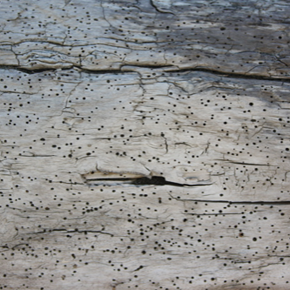
What action should be taken to stop woodworm?
Robert Owen of Timberwise discusses the problems that are associated with a woodworm infestation along with ways of treating the problems.
Woodworm is a term describing all wood boring insects that attack wood and timber and in turn, can cause structural damage if left untreated. Woodworm are attacking timber in properties in the UK right now and the amount of homes being treated for woodworm is now at around 5,000 per week.
The signs of a Woodworm Infestation
It’s important that all woodworm infestations are correctly diagnosed so that the correct method of treatment can be specified. The main types of wood boring beetle are:
- Common Furniture Beetle (Anobium Punctatum)
- Deathwatch Beetle (Xestobium rufovillosum)
- Woodboring Weevils (Euophryum confine and Pentarthrum huttoni)
- Powder Post beetle (Lyctus brunneus)
- House Longhorn Beetle (Hylotrupes bajulus)
The most unfortunate thing about a woodworm infestation is that any signs of the woodworm infestation are only visible towards the end of the woodworm lifecycle. The amount of time the woodworm is in its destructive larval stage can be up to a shocking 4 years.
One of the tell tale signs of an infestation are the small, round exit holes. Theses holes in the wood or timber can be in between 2 and 5mm in diameter dependent on the species.
Another way of identifying the type of woodworm is via the presence of bore dust or to give it its technical name, frass.
Frass is essentially the waste product created by woodworm when boring in timber. Frass is light in colour and varies in characteristics dependent on the species that has created it.
The Process of Removing Woodworm
Just like there are many various types of woodworm to look out for, there are a number of ways of removing the woodworm from the property. When a technician enters the infected area there are certain stages of preparation that are completed before the treatment is carried out. This involves:
- Moving any furniture in the area
- Taking up floor boards if necessary
- Cleaning down timbers to ensure that they are free of dust
Once the technician is happy to proceed they begin to treat the infected timbers using insecticide treatments sprayed directly onto the timber. The solution is then absorbed into the timber over approximately one hour where the eggs near the surface are killed off.
During the woodworm lifecycle the treated timber will be absorbed and once they emerge as adult beetles from the pupal chamber, the beetles will become infertile stopping any future infestations becoming established.
The insecticide treatments used are designed to reduce the risks of exposure to people, pets and the environment. Seriously affected timbers are usually cut away and renewed, where required structurally. Alternatively, resin repair techniques might be deployed.
Preventing Woodworm
By the very nature and living habits of a woodworm, they are unpreventable, although there are a couple of useful tips that can help keep these pests at bay.
One useful tip to take into account is that wood boring weevils are mainly attracted to damp and moist timber. So it’s important that your property is kept dry and fully protected from dampness so the woodworm are not attracted to the timber. Another tip is to make sure that all affected wood is removed and replaced to avoid the woodworm spreading.
When dealing with a severe house destroying insect such as woodworm it’s always best to seek specialist advice. Identifying the nature and severity of the issue is your first priority; in doing so will allow you to take appropriate steps to eradicate the problem.
Latest news

18th April 2024
Abloy UK showcases new digital portfolio at The Security Event 2024
Abloy UK is set to unveil its latest line-up of access control systems at The Security Event 2024, welcoming guests to explore its cutting-edge electromechanical and digital solutions on stand 5/F50.
Posted in Access Control & Door Entry Systems, Architectural Ironmongery, Articles, Building Industry Events, Building Industry News, Building Products & Structures, Building Services, Doors, Exhibitions and Conferences, Facility Management & Building Services, Health & Safety, Information Technology, Retrofit & Renovation, Security and Fire Protection
18th April 2024
Strand is a Failsafe Choice for Emergency Exit and Panic Hardware
In times of emergency, you’re in safe hands with Strand Hardware. Although there are many considerations for building specification, few decisions can be as critical as selecting the right emergency exit/panic hardware.
Posted in Access Control & Door Entry Systems, Architectural Ironmongery, Articles, Building Industry News, Building Products & Structures, Building Services, Doors, Facility Management & Building Services, Health & Safety, Restoration & Refurbishment, Retrofit & Renovation, Security and Fire Protection
18th April 2024
MRA appoints Callum Budd as Research Projects Director
MRA Research, the research agency focused solely on the construction sector, welcomes Callum Budd as its new Research Projects Director.
Posted in Articles, Building Industry News, Information Technology, news, Recruitment, Research & Materials Testing
16th April 2024
Mitsubishi Electric set to host CIBSE Journal webinar
Mitsubishi Electric will host a CIBSE Journal webinar on Wednesday 24th April 2024 at 1pm to discuss the legislation and initiatives driving changes in the way we will need to heat, cool and ventilate large commercial buildings to reach net zero emissions in the UK.
Posted in Air Conditioning, Articles, Building Industry Events, Building Industry News, Building Products & Structures, Building Regulations & Accreditations, Building Services, Facility Management & Building Services, Heating Systems, Controls and Management, Heating, Ventilation and Air Conditioning - HVAC, Information Technology, Pipes & Fittings, Plumbing, Seminars, Sustainability & Energy Efficiency, Training
 Sign up:
Sign up: